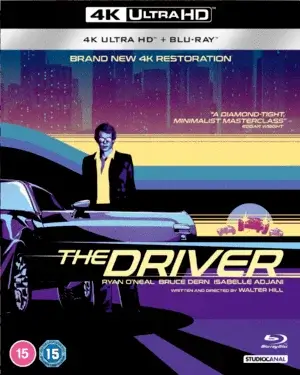A stubborn cop is on the hunt for an elusive professional criminal driver. When a mysterious stranger shows up on the case, the cop decides to set a trap for the driver.
4k movies reviews
Surprisingly, in more than thirty years, downtown Los Angeles hasn’t changed much. It’s just a little more glamorous, there’s obviously more glass, the Skyline is more expressive, and that’s about it. And still lonely hearts drive big and powerful muscle cars in the night streets of the deserted downtown – for fun? Not at all – for a living. And after all, the ability to steal from the police, knowledge of the hidden corners of the city – is worth a lot, and paid accordingly. Ryan, no, not Gosling – O’Neil as a silent, unreal night racer with no name and no past, a modern cowboy on an iron horse (here the desperate detective calls him “cowboy” – if only because he is white, with a country face and obviously not local), sending cars to the garbage after the “case” straight, however, as well as women; big-eyed Isabelle Adjani – as a player and a rich concubine in the care of the unknown. Both have a strange twinkle in their eyes, an invisible attraction to each other, an almost infernal attraction to adventure.
“The Driver” by Walter Hill is built according to the classical canons of heist films: there is a certain risky hero, despite all his meticulousness and caution, who nevertheless gets involved in a game not too profitable for him, there is, in fact, a heist, a dour tracker, powerful cars and a couple of spectacular night chases, in the end – the long-awaited profit. It would seem that the whole mess is about money, but no – because of femme fatal appearing on the horizon, and, of course, she – a cold brunette with red lips and innocent baby eyes. How can one not help it? The noir aesthetic here is somewhat decorative and serves only as a stylistic element, without penetrating deeply into the context, inside the plot, without broadening the horizons, we can say more – noir in “The Driver” remains only at the visual-verbal level, in other words, The protagonist does not die and does not go to hell, and he will not get anything from Adjani’s heroine – only a couple of meaningful passionate glances, and nothing more, sexual initiation, after which in canonical sense all the most interesting should begin, simply does not happen to the fallen angel. It is as if the hero is constantly trying to avoid rapprochement, to pull away, delaying the end, while she, the femme fatale, does not even seem to mind anything more. It is no coincidence that their further relationship remains unknown, in view of the film’s conclusion. This moment makes it possible to interpret the useless noir raid as an attempt to redefine the genre without deconstructing it.
The compilation of the story and the visuals both spoils and exalts the film: On the one hand, everything is very simple – in favor of stylization to the obscure noir of the forties, the characters are simplified here, and the characters are written so that they give the impression of being deliberately formulaic – almost all are silent and mysterious; on the other side is the powerful Melville style, the almost impeccably filmed night scenes of driving around the city, the exquisite camerawork of Lathrop (characteristically, exclusively in the action scenes) successfully focusing on the light of burning headlights penetrating the evening fog, the fanciful reflections on the windshields, abandoned industrial buildings, warehouses and garages of the industrial outskirts of LA. The main soundtrack becomes not artificial music, but the roar of motors, turning a little, but very vivid action into a manual for all aspiring cameramen on how to properly handle light, sound and camera. The audiovisual effect for seven minutes at the beginning and end is like bright flashes of headlights in pitch-black darkness. The melodramatic line looks frankly weak against such a backdrop.
And yes, the chase scenes are extraordinarily beautifully shot, yes, the style is the most expensive, it overshadows everything else, relegating the narrative to the background, yes, Adjani occasionally screws up and looks inappropriate and at times downright silly, and the dissonance and lack of soft transitions between the “heist” essence of the movie and the “black” picture may upset convinced postmodernists, but, in fact, it doesn’t matter, and has anything changed in cinema since the late seventies? Röfn has almost frame-by-frame remade The Driver, flattening the traditional structure of sixties-’80s racer movies and borrowing from Mann, Melville and other good, good, good directors a lot of good, good scenes, patterns, dialogue and all sorts of little things, created the amazing Drive, and now he is no less than a genius. So what’s Hill’s problem? That’s right, he stole too little and didn’t go for a complete rethinking of genres, sacrificing the cinematic text in favor of a beautiful illusion. But what, after all, is cinema but a beautiful illusion? It doesn’t really matter when this illusion appeared in ’78 or 33 years later, does it? All that matters is the ability to steal and compile, to steal and compile correctly. You have to be a little bolder, and that’s the only way, otherwise they won’t let you in. Otherwise they won’t notice.
Info Blu-ray
Video
Codec: HEVC / H.265 (89.8 Mb/s)
Resolution: Native 4K (2160p)
HDR: Dolby Vision, HDR10
Original aspect ratio: 1.85:1
Audio
English: LPCM 2.0
English: Dolby Digital 2.0
French: LPCM 2.0
German: LPCM 2.0
Subtitles
English SDH, French, German.

